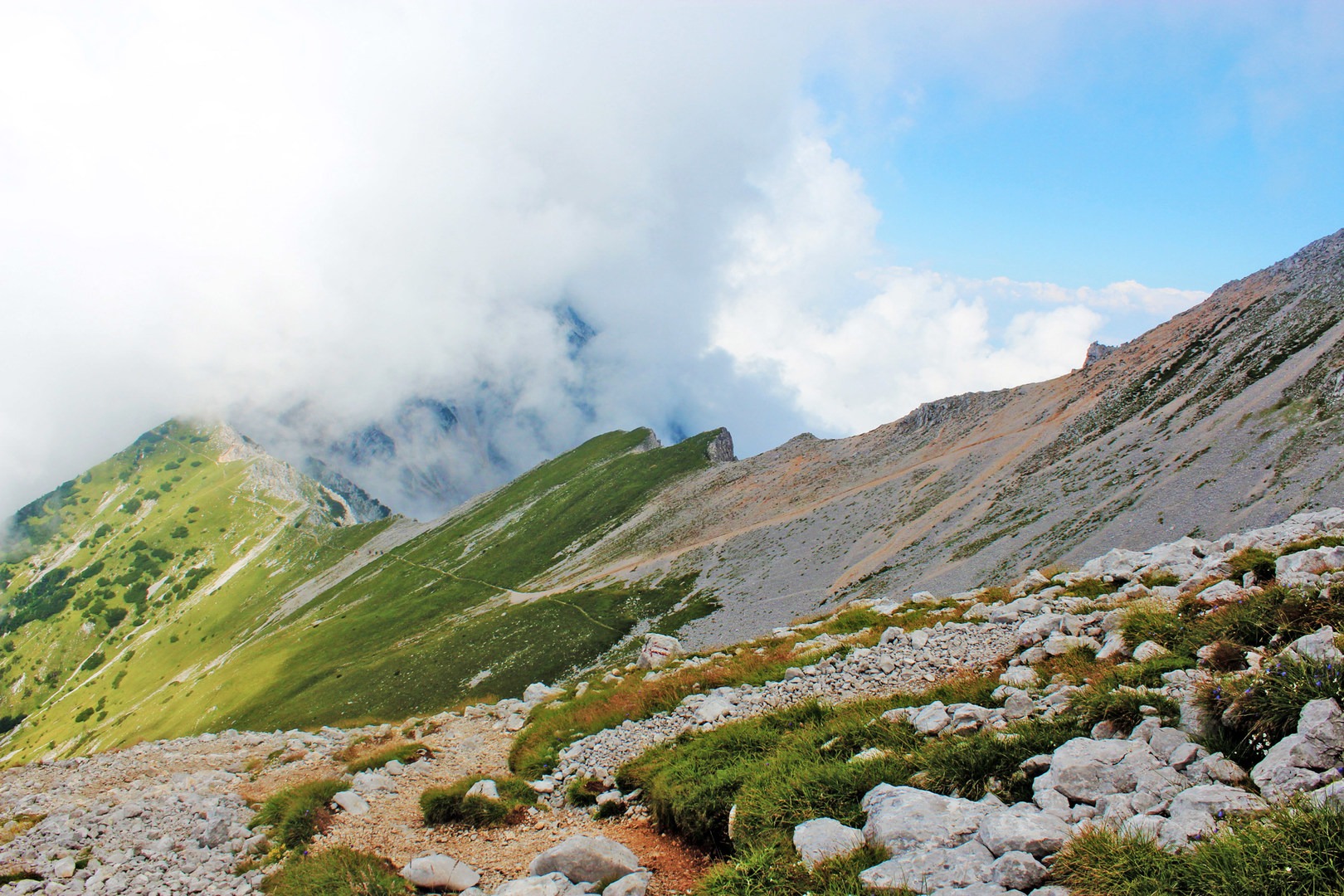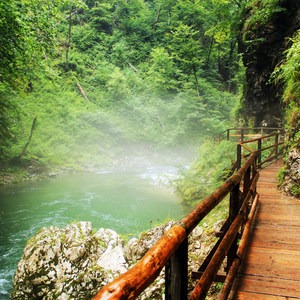You are here
Bled is well known on the European tourist track, most notably for its iconic and perfectly picturesque Lake Bled with a single island bearing a lone church. No roads, no causeways, just a little church in the middle of a lake. While Bled attracts many standard European travelers looking for good cuisine, lovely architecture, and quaint towns, it’s also a hotbed of outdoor adventure, such as canyoneering, low-class river rafting, and zip lining. Lesser known, however, is its merit in the world of hiking and mountaineering, in both the Karavanke Range immediately to the north and the Julian Alps to the northwest. Stol (its Slovenian name), also known as Hochstuhl (its German name), stands at 2,236 meters and is the highest peak in the 120-kilometer Karavanke Range (Karawanken in German) that spans the Slovenian-Austrian border.
From the Slovenian side, you can experience a little bit of everything in terms of terrain, from rolling meadows and farmland to overgrown old growth and desolate, rocky alpine landscapes. From the harsher, northern Austrian side, the Karavanks bear steep rocky ravines and loose talus slopes too unstable for much pure rock climbing, but they provide excellent Class IV scrambling and even some optional via ferrata routes. In the winter, the Austrian side bears stellar steep ravines for alpine climbing and chutes for skiing.
Stol is accessible year round, though in winter months, even the easiest routes would require at least basic mountaineering equipment (i.e. crampons and mountain axe, though anchoring equipment should not be necessary for most routes).
Most routes are easy to navigate and bear clear signage, both directional signposts with time estimates to the destination (which tent to be on the slower side of generous) and red and white circle targets painted on trees and stones to mark the path.
Valvasorjev Dom via Zirovniska Pot
While there are many different routes to the summit of Stol, this description details the most common and accessible route from the Slovenian side, Zirovniska Pot, from Valvasorjev Dom mountain lodge, located not far outside the town of Bled along highway E61.
If you do not have a car, it’s easy enough to walk to the lodge, which adds a few kilometers of easy walking onto your trek, or take an inexpensive taxi. You can also hitchhike, and rides are easy to catch. Note the last 5 kilometers of the drive are on a steep and narrow but well-maintained gravel road that only proves difficult in winter.
From the lodge, go east, following the clearly marked signs pointing toward Stol. After 800 meters, you will reach a crossroads, where a directional sign will point left to Stol-Zirovniska Pot and right to Stol-Zabreska Pot (also known as the Zabreška planina). Either trail is suitable and will lead to the summit, though the left trail is slightly shorter and gains elevation a little more quickly with more spectacular views sooner. The best route is to go up left and make a loop of the hike, following the right trail to descend, making the descent a little less steep and jarring on the knees.
From there, the trail narrows and ascends straight up the mountain. While this route is not technically difficult, it is physically strenuous, gaining over 1,300 meters of elevation in only 11 kilometers. Be careful of livestock from trailside farms during the first kilometer or so of trail. This includes horses and free-range cattle, the steers of which can be especially unfriendly if spooked.
After 2.3 kilometers of sustained grade through dense forest (about 2.5 hours from the start of your hike), the direction of the trail will shift eastbound as you begin to rise out of the treeline and only the white rocky slopes of the Vajnež ridge. Hike another kilometer onto the summit of Mali Stol (2,172 m), a minor secondary summit just below Stol itself. Right below this summit, you’ll find the Prešernova Koča mountain hut. Though it is only open from June to September, if you are hiking in those months you can stop and order cooked meals and drinks here.
Pass the hut and continue along the northeast trail, which will drop you slightly into a talus-filled bowl before it ascends once more up to the Stol summit, where you’ll find a lockbox and trail register, if you wish to add your name. On clear days, which can be a rarity for an often cloud-drenched summit, the view is utterly spectacular. All around, you can see the various mountain ranges of both countries, including the Julian Alps, Italian Dolomites, Hohe Tauern, and Gurktaler Alps.
Look south to the rolling green hills of Slovenia, including Lake Bled and Bled itself, or north to the wild and precipitous peaks of the much harsher Austrian side. Be careful of your footing on the summit, as one slight misstep could lead to a nasty tumble down the harsh Austrian side that drops off dramatically.
From the summit, you can extend your day to bag multiple peaks by heading northeast on Orlice Ridge, the main ridge of the Karavanke. Many of these peaks are sharp and ominous, and attempting their summits is technically challenging. In order of appearance, these adjacent peaks are Krkotnik (2,116 m), Celovška špica (2,105 m), and Jelenčka (1,964 m) ending at Belščica notch (1,840 m). These routes are rated primarily UIAA II, with one UIAA III section.
To hike back, you have several options. You can either make the hike an out-and-back, retracing the path you took to get there, or you can create a loop. To do this, return to the mountain hut, Prešernova Koča, but instead of following your original path down the mountain below the hut, descend into a scree-filled bowl to Finžgarjeva skala (cliff). In this bowl, you will find a crude stone well hidden among the stones with a little pink teacup with which to drink some water and rehydrate. Keep following the path down the switchbacks and back into the forest. Just before reaching the original fork near Valvasorjev Dom, pass through a field of cattle, the steers of which can be aggressive. It’s easy enough to skirt around them.
Alternate routes from the Slovenian side:
-
From Dom Pristava (46.454254, 14.091628) via Javornik Creek: five hours, more technical scrambling (primarily UIAA Class II w/ some UIAA Class III).
-
From Dom na Zelenici (46.429195, 14.233500): three hours, easy to moderate difficulty, traverses under loose rock near Vrtača Pass (helmet required).
Alternate routes from the Austrian side:
-
From Klagenfurter Huette (46.446714, 14.183054):
-
Over Belščica saddle: most common route from the north, two and a half hours, moderate steepness and difficulty.
-
To Potoški Stol (2,014 m) and over Široka Riža or Dolga Riža (further west): three hours, difficult steep scree chutes mostly used for descents.
-
Via ferrata north direct: three and a half hours, extremely steep with moderate difficulty.
-
Janežev žleb and Martin žleb: unmarked scree passages leading to eastern summit crest; difficult.
-
- From Poden/Bodental (46.462651, 14.212569) via Vrtača Pass: four hours, typically used in winter, extremely difficult scree slopes.







Comments
Sign In and share them.